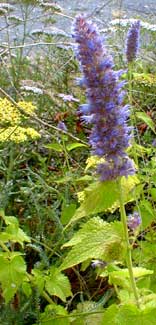
Golden Anise Hyssop; aka:
'Golden Jubilee' Licorice Mint,
Blue Giant, Fragrant Giant, or
Lavender Giant Hyssop
"The priest with his hyssop sprinkles the congregation, & scatters blessings upon them."
-Henry Wadsworth Longfellow
(1807 - 1882)
"And a clean person shall take hyssop, & dip it in the water, & sprinkle it upon the tent, & upon all the vessels, & upon the congregation."
-Leviticus 19:18
(1807 - 1882)
Agastache foeniculum 'Golden Jubilee' is the recipient of the 2003 Quality Award in the Fleuroselect trials across Europe, & the All-American Selections Gold Medal when trialed that same year across the USA. For the ASS award it scored the highest ranking for length of bloom time & ease of growth.
The name 'Golden Jubilee' commemorates the 50-year reign of Queen Elizabeth II. It was the very first golden-leafed agastache, bred by K. Sahin Zaden in Holland.
 By late June, small bluish purple flowers top twenty-inch tall spikes, over an upright compact clump of foliage, golden to chartreuse at top, lime green toward the bottom, & these very long-lasting blooms slowly increase in length in weeks to follow.
By late June, small bluish purple flowers top twenty-inch tall spikes, over an upright compact clump of foliage, golden to chartreuse at top, lime green toward the bottom, & these very long-lasting blooms slowly increase in length in weeks to follow.The first photo shows a typical blossom as it appears in late June or early July. The second photo shows the gorgeous foliage in May before it blooms. The third photo shows the flowers in mid July, when they have swollen considerably. The fourth photo shows the impressively lengthened flower in late-July & August, at three our four inches length.
The regular wild form grows as tall as four feet, but the golden variety will likely remain well under three feet. The flowers easily last from June to October in our zone. When the flowers are finally done-for in autumn, the leaves will be getting scruffy, & can be cut back.
 It is liked by hummingbirds & butterflies, is extremely hardy to zone 6, or with protection to zone 4. The species is native of the United states, growing from Washington state to New England all along both sides of the Canadian borders, & down into the American Southwest. It is cold-hardy in dry sunny locations, & far more humidity-tolerant than the majority of hyssops.
It is liked by hummingbirds & butterflies, is extremely hardy to zone 6, or with protection to zone 4. The species is native of the United states, growing from Washington state to New England all along both sides of the Canadian borders, & down into the American Southwest. It is cold-hardy in dry sunny locations, & far more humidity-tolerant than the majority of hyssops. It's so adaptable because it grows naturally both in dry harsh thickets but also in prairie conditions that are seasonally spring-wet & summer-dry, in a variety of soil conditions from acid to slightly alkaline. It is good for a xeriscape garden, but the golden coloration is best with light to moderate watering in well-drained soil. It's also a fine container plant, tolerating considerable neglect.
It's so adaptable because it grows naturally both in dry harsh thickets but also in prairie conditions that are seasonally spring-wet & summer-dry, in a variety of soil conditions from acid to slightly alkaline. It is good for a xeriscape garden, but the golden coloration is best with light to moderate watering in well-drained soil. It's also a fine container plant, tolerating considerable neglect.Hermaphroditic flowers are self-fertile. Seeds ripen in autumn. First year plants started in autumn coldframes or indoors in trays & put into the garden in spring will bloom by August, but in years after it will bloom beginning late June or July.
If deadheaded before the summer flowers go to seed it will bloom all the way to October or first frost. If permitted to go to seed, finches will visit the flowerheads to eat the seeds.
A useful herb, the highly aromatic leaves can be used for tea that tastes of licoricy mint, or dried for poupouri. Young leaves are tasty raw in salads or fresh fruit-cups; tougher older leaves can be added to cooked foods. Extracted oils have been used in food flavorings. Chinese herbalists believe it is useful for heart conditions, though there are no well-designed double-blind studies to lend credence to this traditional use. It may more certainly help relieve cold symptoms, as its mildly antiviral properties appear to be legitimate.
See also the very similar Purple Giant Hyssop A. rugosa & a hybrid of these two hyssops, A. foeniculum x rugosa 'Blue Fortune' Anise Hyssop.